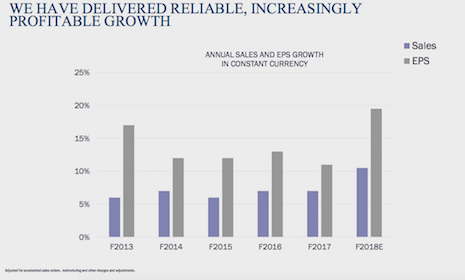Beauty conglomerate Estée Lauder has seen massive growth in sales revenue over the last fiscal year driven largely by the group’s mobile-first, digital-first ethos and the rapid expansion of the Chinese market.
During the group's presentation at the Bank of America Merrill Lynch 2018 Consumer & Retail Technology Conference, CEO Fabrizio Freda spoke at length about how the company plans to take advantage of its favorable position in the market as well as what strategies brought it there. Mr. Freda was particularly proud of the time-to-market improvements Estée Lauder has experienced and touted the company’s impressive flexibility for its size.
"We used to have 18 months to market, now we are at 12 months for our big changes," Mr. Freda said. "Many of our small changes can go from development to market in just five months."
Online growth
The global luxury industry is growing at a steady rate, thanks to strong showings from China and a bounce-back from the financial crisis of the late 2000s.
Estée Lauder has found itself in an enviable position as a purveyor of some of the most prestigious brands in the luxury cosmetics category. The company’s return on invested capital sits at 21.9 percent over the last five years, the highest among luxury beauty companies, compared to LVMH’s 14.6 percent and AmorePacific’s 14.3 percent.
The group has stated that online sales, which began more than two decades ago when Estée Lauder was one of the first to launch an ecommerce shop, have helped boost the brand’s overall revenues. Consequently, the group now thinks of itself as a primarily digital-first company and leads with digital and mobile on every project.

Estée Lauder has diversified its growth. Image credit: Estée Lauder
"Our expertise has made us a leader in social media communication," Mr. Freda said. "We can see what drives traffic and engages users.
"We were pioneers when we launched ecommerce two decades ago," he said. "Our online sales have been growing 25 percent on average driven mainly by mobile."
Mr. Freda pointed to some of the mobile and multichannel initiatives taken on by Estée Lauder’s brands such as La Mer and Tom Ford as being examples of how the company puts digital first.
Estée Lauder has launched digital tools such as live chat with makeup artists, click-and-collect, same-day delivery and loyalty programs to reach the online shopper. Investing in omnichannel, the group also established its multi-year Leading Beauty Forward initiative.
"One of our strengths has been the reliability of our performance," Mr. Freda said. "Despite economic and political volatility, we have achieved significant gains year after year.
"We forecast sales growth of 10 to 11 percent for fiscal year 2018."
The China effect
One thing that Mr. Freda stressed in his call is that Estée Lauder’s commitment to digital is not confined solely to its consumer-facing products.
Instead, the company makes use of digital in all areas including training its employees. Earlier this year, Estée Lauder expanded its use of augmented reality technology to its retail operations.
After launching a series of consumer-facing activations using Perfect Corp.’s YouCam application, the company has created an Augmented Reality Training (ART) program for its Beauty Advisors. Virtual experiences are being used more often by brands to streamline aspects of business, from training to technical work (see story).
Mr. Freda also emphasized the role China has played in the company’s growth and the potential long-term effects of investing in China.

The company's continued growth. Image credit: Estée Lauder
Asia’s bounce back as a major luxury goods consumer market is one of the factors supporting beauty marketer Estée Lauder’s 17 percent sales growth, as reported in its latest earnings.
Estée Lauder saw net sales of $3.74 billion in the quarter ended on Dec. 31, compared to $3.21 billion in the previous year’s quarter. Estée Lauder attributes its positive sales to growth in Asia, online global sales and travel retail (see story).
"I think China is a long-term opportunity," Mr. Freda said. "This will be probably the biggest opportunity in the future. Overall Chinese consumers are really passionate about beauty.
"China is not anymore only a skincare engine," he said. "They are entering into makeup in a big way.
"China has grown from a single engine, skincare, to multiple engine area."
{"ct":"R2+hH+5wuQSu0iOhWATMYyzJdT9HCcQPSmLA8b+q80wtUR26ei7k1fiD7D6W4LTWzQXRqcMJryMaZwrdSXPjTsh5Pj6EE6z2vruOLSpslE8\/5Q5B2iiFvri4rqM+cOpYjMzoLoqEFdiswZ01i0\/pWKn6DBUZ1gT+OyQIkvreJuiRUCvqHOx\/9pq5aZc11OQ4IFxUmegHJa2V834hcrFd4y1y5wK\/eQ2KECtXVEmmtGZj36gKX72uOMG\/CMyouvrl9ux3RHXRX7f\/Dfhh96L3+QBORxwvx8d\/dHm7pl96j+JebI\/ujuxTqSySeGKpKoccbEKXPmloeiDyPMZyCGlKWAxR0O39d2FOeAL4nt4U++lV1UQGK6L14m\/dLlWT8o8aVDXsxBZZ\/JdPP6Q4qOj0DnR0QeCtG9b7UtxRS03TMyOay0uAshOT9UdFmMR7qkpb2PTZl0mi3XmrMufGJlm8HZhnKX4fB2CyoKrnyFio1TTxQ9HU6n3hL2dXWC7EdNCpMkgpwwtm50afMeRRu7OqJuuvtbcYB9t1RgvqB6XTT3zcoooO18+t3LR+9ZUqrzBPBwkRXHvCPG+rmp6WUPQ7c7UiaXBAI0rdvWyZITIRKn8b4qzqL0yK7DDOtXbwFnL8cE3Zz6115JD1HFs\/i02ZZDYvaleqvrCY2q2uo9hF6S5ODcfBstM\/SY5o+4TQ7C72Rj\/PMXxvkB1DfusQoZ47wH732qhrL1jaRm1SV156bG7RH25XlvHr0nEsvKjBBjf4cBHSul7ZXy3GIVeOqIliSrwbrAOOvP5X2Kt6+abh6faUXE8yPZkAZWl+VD12\/8FyLZH0aEK9HKCeuork4AfGXzS12ffPqpVxTReexgfifYQ9pkwOo3XnkuvwrXHOaI+QJV8iSmt5Mgpt7\/rosMU+lCNEubFV4FQmzj4hV6\/Vu60RYDWeXjcz+OwxgVvqKZmHWeplghi+N4xDwhPBBKJd7AoAVgMDGrkdGcggEdFus07sIdUTTmB7AFPMMu3ZCVii2BYx9gJSRzJL5I3cl+TwpuQtoBV3\/o4pj7e8I7atq0rvH1lcIl8TMmevoMlRkc3FYw7dyCzu+HjfsROtfg6fojR\/CkZL8O5GfYnMed7IqB4BC0UfNQPQIleczDI2btzk5nGK5Sg7D9xc7rv2YQoI\/0eEjwkXqNCJJyNu\/vNzo7XAEceNIPSJltH5EIMQM9LR+SEFjIuyY1dUdsXzg86dt0ewbhZmgjYc0OQAR2fvT9t\/IEOHaJz3nCHEplKSsN8dQJH7hdLRcSWYbB3x7vBS0eIVX1fbCsmBhxfNTJZKBvNqguQQTPK9y81MIUypkgcyN9xCiUTyo1uj2NO\/SJtApcHaIIn4iicwK7ODK\/HEhmahiUnmV7AMZ\/lRYQ3prT9+x6J4leaB2KoEUvboKV2c2fXD5gZr6NLI6FpWy2X18SQ63kliJRqTfxUWshYJQUgKgXawfTyRdEDhHUiqAC5CuukIDlxREKTK0ho7cHe1STmOSXGi+G27R\/PQT29GaNMUAnDS+VGSQM3j5olY5ml0cCxBD7KsAbtQELfk+sGTkM2d4Kh76q97Dy8Q1nV3CS9AxXsrSkzTYIOfnq18V1U+p00I4w2Eqm1UXHYawp3pCYfA12RT2TSl1w0peZJvkVDeEMzG+WgZOyN2Kcr6\/Yq3lNl\/ZMj\/rgZP2qtBm\/qYDZJIKECGJWOvPTnsYKmqm7Q8O\/UW\/7cjSGJftx5+phknaRxKJfJ6cHgvL2D922wb6v4\/ok6A0MphFryt8teriWMJvzxhsoeX333c\/1PWVRvykMQmQ9GMT62ItmJTZn\/\/xAiQzlbedIA3mmNWJnaDqTZxJLQvJN1r5RNv3S4qlfA630fync2BqgGPWIrwpzXX3SUHGAoqmpdyT2sFaKRJIsQ8Qq93W1p7djDMokGLX\/mQulOZ7qcyj9OgPaozuMf5gbvj9C0MKopyz+r0tcJUQGXsD9LYmn3wHTf3mYvqZ5Lv38SpMas3XBMWWwNWouiWEQZlMOXjhP8yRqwenXtl4zo5QmrKDRuNpxeguTbzp1NCtEWeSEUa5fhZyyAH+OaNh+Aek5BAX4nZ2kyH6sYZx4fyCOely7hVARX\/Uk2oS5J6bqgkBIUdx6TB8qdTxWJkKW33F5E0VX5huTCojfBkuurBrrKM0zcpVarqX\/QoMx7fcmQ0dtt3HWwqG80OF6ZnPu0TahEQ\/K2Pm3+dLJiuSKWf08QkdlqtDcHkcSX6D3F4CoLresljuS+kwBmzQK0eIMh65wFpzsdwqIfV2bFreyC2M8GGBBdNQ0kRtrbR9skG4XuvO30ptScEdQzcYnRhAtn+UvyIMKvu09sxvX8MBGMaVS+txa+WwtRUoRHxnj4BRf7L0YaIb1goasm5j22Aqfy27Vvm\/axoH5Dl3Mp7HzvhPrb+Gambn99LtlHFtxMbVy2STTr\/8rH2lNgxyla4FN1StCxWa1sNMDv+yKzAxtLtrHF8tePz3nztXnLaoCECJaw5MDjHHVtiKddhZGYDMe47cexQlb4UzakLcw\/7FQxU2BE2VW+z63yD8sWWPEDJru56vg+MhHnfcyMhr2OvslICYccQLn05IXyei1nzmSOFXKNHqm6NBvUDeW5TSXJ5jg0+ma4bR41BVVXbPI9lgkM6\/Vnee9vWoT4RJopOWUx6MrD2V0ol7APM7m8eEZIMAVKZk2Gww3yEJ9K0t5splJ+0QoXQJhSGR3JVGZraTCWHpuwtWE\/TmNAtivlxJlOTL09MUqO7VnabdWndfC5EpKgo2t5fakipmlRRawdKCQclXsmC38mKa7UV1NMPCGDmYetuYFR0WX7BgBuc7zypACcVVEYb8KH\/AZHJmX21f3fQz4E61E31td1f8oXW0IXONOHVueO4Y8QNmUALBeJI83SDoY3rHW5LeOB5HUnlg2yvGtYfjQI8gtrnZ8W2wYB8uFStX84nb7PTIl+vz3x2VSF0BMjRKXoT9DzjUPyuYgxRRUNbIfxW7foZ1xg0ig2diMkG3DT2E+hcgkYr+kSe109AMGUNu\/iw6Kv8R2b5ND8AGv5eLqyF8BCTlDzqbXP9dUCkG\/3sZXwEgxigRLtIjOo969M+ETZip6VW8TvTdoO4gdaN7EdUGs5cGaXyptSBTs26YIIdbfhjQ+Si3V1MPjoJnwsMdVHyY1fn5d4nH5d\/8F8Q7AEG4Ue1czgloaZ0NioXNiD6gDLLSsgLw\/kl20epk2vLJeT04gweQ9FZdNMWL0zMOmvGN8\/xCBxaSWXA6WMloi2fxkI5owl4xWdvfNaQ1vtCL+U3zb7j3rho6IhLcpq1PnHg\/ftrSa2uBSDK0Br0OOIijNbHeMwSjB9zk0Ns00SRTrSMN9wQvzwxki0msaUIsMZQpDYmmy4eqNjqkJl5t7\/pJjNaT\/rLuCzLiywe7KFWSNOns4STRURItCRTAkIZ616Wr1hjtcKC26qHIDNRUOWo4PHcqyl7V0Wt9yhMar87JN+dTBypWl5V77Xnw7EbVA5\/v1jb8ZzWdJI7j1fJ2aSwmdVZfZyVWhNPbIpN1DOZE+SS5ylTXAWiGE+eC8J6BkQixvj2YeLkPznH7liZAFlRUIlwLb4lWyVDFCDMsT0s7v1ulfTKA7x2LzhAe4rV1F3gcsqvXr\/Ym9RkE3rKuuQAN1+3ZyYXvsoeIwkZQ97+p6fxFU6mB+TqoyI8WDQzeuNeLOe8sarJuSYaHz8dtVUHCrz8FHIbQrWQ7NIbQOKFqqp8J65TwqE1S4GEIpLz\/dY+RSmrpOiJlFjHtKC46aHs2a3ghiyyn3Dpu6VJERzc9fnc7e8lyOyl\/9mdDcPJvXbArzQrWbbNEyeW8aG3AndVfTdBhgCXoAO6ES\/xMw5diMqoEOZR9soo1UGmJVrSUZvnV6grwg\/eHbA1SmblWASOJUREEIb2svO6K8NCAoDOHoXxpuLabQ7dN5bLFx6IcWBfro++exnDxHh3r0DpfWMkQ3vZnrP8WTQ5p\/FWA0IeCmhpeQTSgW9d+ngLSgenx7Z2C8Is9VkB1dWDeh9hOUhasgu46C\/icH7wTiUpP\/QhU+Pbf\/kGLsvfW9lOFmLwXLUY8kVWRzmbNj2vpHC3R+BXnsZ4Vc9N8pGO79MoQHxjJtg\/wB9Um9dvDU+7AAhxqfUN1NjTao2w15qa8qvFkhNhOjaTIdyYJ+EvhNJtYE08M+iqqUhxQoIL9gkl0xPfc8bePYLp8+t2BVhTdXqUQS3reg0iI\/giPDZuB7ndB0nZ1\/nvGOOu3\/HAQI1W1V+QduTI9Q15ic+5fsEtfNVxokF0RqDsozYS\/t8\/6Hw45kMLveD03+qYG29IFodfH1YUM8\/Ui01c4lI\/+wutyDOtkIq+3D2iepSFjDhvPdgPRxdba5lUPbZFFwSITy41++z1vm34H3zvqR8\/gnegfC8wpIAOFixSPI8k2fcVZ7g7tDA6JuQ8U8\/0LyoHNwLraWwkZdtCDUe1JG3TBSHxusWnIivIUBJJLU0avjAvY3xTyr7dy6SY5e2yKebSvU0tTSgitT2cpG+3tgzX5vQRX8bSA1BfMTujCqQXrEgVzogIJINq5zTmA\/Np4Kzl\/6DW8IlPTnsWP3aZ8IgqkkjCBwrZVZzGQL11WU1sssO8Uscuf0iaA3Vj1AoNCW6HskR+zoPLmHrIPk6Cu8FgkShcBG4YV1cHr0qbnlI9cgbcvC+VT2FfJF8HOGOA+ARZcSx74DVFjmEENisOktHRkvObsRV\/9dz2i86nCv0lrRoHqshdHFVZGL\/M\/6AZg2t9CvhHgGBn0rGs22RqS8mHp\/cPjYea+DwwthBk\/BFKibp9m+k3ndpFvJkpwOPH54b\/MLV246j5G4uDuPix4h1ZbuUwVKnaw3Pd+4DBetyrFNmKmjj+y7OnFJP4fa5rWCAyaKdZU6edZ5D5zJA002V63nhFR9Wp0884zabAQlJZJHy\/sxJKIiMK0S7cqiBtKJlzQFFw9W5sUGDc5nxTPZX2p5u2wBAfXy98tCNiEX57sz1\/\/EaPafqan43Xvwk2jIke7MTVBUingHxA3FZE7qwFJRBtvM72byBuUtnSVfmMh+Jaxwflbfh3rGK3xOiLcJr6t6bj11Jvpit6kIEpfeR3zf7iPIVKfJ1yObXOlL7NQmO9s66yrF19rg4dfFQ9TUHbW5ysYPitoGR2Ulo+vJLAthy2ILqVswN+DN2mk6YVo3FPY4J1JfhE\/44J\/jci9SGgGfoasNeSNRQyp3VCzdXvnqlKeGiErxJjc4A4wnyvFL7wnzLTBd3t3NRtleOeqkOKRJjmCV0LS8xdA035g8akuyZI3TY\/eKu3EpUJUgNfuxMOC6udGsqDey3GYszs5RRy5qSF4wEIDTd0SbZqfW8DvFyrE+dP1HYCF+mv4BNbnIGJdj0CbNXWloa+pJeor76Zu3KVCZx2Np\/A6vb4k\/\/fCXAmREAWVM2KjeB5xh1Nxb0xr2X\/w2T0iyMhbsGU6UYEQzRM1Xb\/ct+cxBDfbYKfZ7q6IkkVAd0vhock0cNNsCBAiFR91t4ey5CHtNlFDfxI14ELJqzR7L6GD3w+943oW8kQt6Jyy+iWUQ2VbzMbsbQ2BiXs9yHxhxnopIkqmeYYpULChcVevLn7ckXlJOO9Qo+mA7Lr5SgoxhN9BaoosXcV6JwdQ91hb7KTxB9d4DJpVb4ukn8Mueqz0gJdQuAMGRs2TJekLmkRMTi7SDLal\/2xPoMYyBWXp6l0XAKD2\/2hrAExRh\/bQler87Si2+zeAsW+lKx9OvtHwpx6r26KVxwWCIwnwVTb0Nhp3MsCePvIXWJpvqYxzAHp28QIxrsDBcFzDNNBnGER4gcyiSRYnLfTgzGq5bC3g6w3zt2abGbMWmdNH4lAk\/zgLjU8+2YxmFJevUQ1qAFZs276HC+aC8e+c3Oluvv+61YJIW9CpSupOLRKRM3GuiMxFVp0pOfaRE1ELYf+But+kO5HTfI5Eo0prUEzp\/0aMrupHSq9a7nRyjjBh8+l+6EymOkID1eOoY2UKoHDs4Q1MTfBCAzWP2l5a1M\/9v5ttrTezL8+wEAbgqJk0SdVQgib67VUnLwy\/+lPF0LHJJsrdc982u2NmgUam+cDi4zIiZy5h3Y4slZZAim\/3u0Z\/412HDcbXOUahpULy0aoCr89ybGcAjNwH08lPWIBofttOMK2l2lGEf6e7fLrbULSX2mapA5pTfjKg8q1qjXu2I4NXbyXpyvq\/+Ci97R9XOhc0mhpkpr0FYv5cPCnqND+E2x5H3x5inYj8Qo9cFyFibRb3IWj6O59Al+RvI0GxfRsuunVYQX5UL5QI3+4nnSOv7csQaMC0A17dG9dE75VOIY0lVi+uY++1VfFITOCTFbVu0iK58obOieF1Nf5GfZBle3Jmwj91l\/iQYhydirdmUyyz\/XbckLepnJ54HGThTaBW5RC9w6ukbY3nHsVmITefD7Fan9BukMzsO0iCKGPdmT9oSlWJxiAB3zffx1OntzmEGphNcBBEbZDopMc5OklUqqHii56i\/k2\/i5DbTrQlTtws5K\/ujJy8sX+B0B1TUctOBP0ZdTiPvmnhAGf7r9mCz+igQ2vGFR2Q2Bm4M7i7BNlYgKB+gSGX8kH+\/v\/qWvrFr20q2hBdubaVFrvj2RifIA3lAAEAGhYsmLFerio81Y9zaEfhOpbWZnaTgZKB\/P6ncp513a+85Z5CBsWOS3CtuSWDqnKQJ6JdPEynj0B1zL9BF9NjeNzErRQs0xNjIe08WMvk3XMNfE0O1Hvs6mBCLog1A1W3p\/Kc3IaHwc19vL+zwMYgzG4Pcsvyn6XzRI7UVRGPr+01Z\/fhvWgeXc0CM289n7aacF1H8zLHK9RVrs4ScU9u\/fYSzRdfDx6WxAjmAZOecTMNVKLUwE3P8OyYVM64eqXNxhqYbYUtX0WTjZgS38VZriVhaMzfv3ISYTsG0pcjAwW6pOjMMIa0rpq8UhMfyqjrrWwm5sv4+kN5x0KRWdR7C78F+qT9aJi0FPz872rMgY++jVJz3hzLpnFJYczrvaysocORiukbE0U05N+BvaVVkIF383qYg1Ivw9ePDbtMx8RWDTp0xV4hxXbKq0y0D0y36SW1HSlJWnzqWms89PxdjActUMbr+5\/76v0FZAja5xIySpi78dvZzJIfcrXVnDXdffmUu02av7ep2Jhm5YdrhWFSYbWcfFTf5BDAzmWnf5UL+ZcskHTSiOV82U3DcjfcEM81\/X65IK2\/ieR0nAi346JeMHZpZBadJW\/DsOr21bL4biDxtVadDdZHBp940bCkUfoJeT89Zpheu0tpsEg0D06U8nlM5h065yb1A2ykOjsbdxJorOc5LVFK2y+AB4J7oQsPrqttktn6yR9vNSy1wQmjVMgzxV849Kw0NAbPP7tVwuVDuNRyI7XBXIPUgTVrmJMKmnAO3k2keM33PckXAJwPMZzyrIsWiFpyx4mdA6pkPpCKEw7OG\/e+YTGGaHp7LOwlghEHzF63\/gFHkK\/Szyz5g\/oN+TUBy5xwb\/qkWB10iv\/hVTXia3IH3mvf\/RFe2NzB9Mpu6etYjBaHYC9ikjeN4jjuA0pPAbC5+8wuK6TR3f9oMo1KoWBk3bMM4zk3PpStqMJZsK2Y4h+KJCkchd9P6Vv5NfE2Y\/yOiVWBsOLEhtmg1YjFrKpHk8y7dnYwxIPSZFbXzL4p6y98\/XgSndCbrujuWYkYfJMr4S5LEyT9BFsgB+M+sH6oEuR9KuD4lqS2Dl5mzNDr\/TUwwrV0SdsWSuRFEP34qJMhuvj+eXWT\/ytYGeC+ffTUl6khdUeddPMor6Pq50nQ7ezw307mFfoax8\/blCzhid69GQYSPoO9HW3l2ePP5gV\/ZshdyBtzyNqwAUF+w==","iv":"fc648c9160db4eb410cac26949f47cf6","s":"30fcbe7cd996a78b"}

 Estée Lauder's Lead Beauty Forward initiative has propelled its omnichannel growth. Image credit: Estée Lauder
Estée Lauder's Lead Beauty Forward initiative has propelled its omnichannel growth. Image credit: Estée Lauder